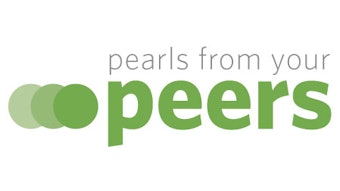The Importance of Communication in Improving Surgical Outcomes
Developing effective communication strategies and a teaming culture in the OR can significantly improve patient safety and care delivery in the perioperative setting.
Karthik Balakrishnan, MD, MPH, and Neelaysh Vukkadala, MD, Patient Safety and Quality Improvement Committee Members

These results, while not surprising, do raise an important point. Much of human communication begins with the foundational identifier, our names. Consider why conferences give each attendee a large, easy-to-read name badge—the threshold for initiating a conversation is much lower when we know someone’s name. Addressing someone by name also has a powerful psychological impact. We have all felt a sense of inclusion and respect when someone remembers our name. This is particularly true for those who are not in a position of power in the hierarchy.
There are many barriers to learning and retaining the names of OR team members. For example, there is constant rotation in and out of the OR during a case as the circulators, scrub techs, and anesthesia teams may go on break or off shift and be replaced by other members. Nonetheless this only underscores the importance of developing creative, easy to implement strategies to rapidly build team cohesion.
Perhaps the simplest intervention to boost name use is to simply write it on scrub hats. In a growing trend, many operating room groups have begun to issue all OR team members scrub hats with their names and roles clearly printed on the front. This allows anyone to directly communicate with another person even if they do not already know or recall their name. This can be easily replicated by simply having all members write their names in print on tape and affix it to the front of their OR hat. A research study in Australia surveying staff before and after implementation of scrub hats displaying names and roles showed increased perception of teamwork.2 A randomized study conducted in the obstetrics department at Stanford University demonstrated increased name use and fewer missed communications in the named cap group.3
Learning names helps more globally with the important concept of teaming. Amy C. Edmondson is the Novartis Professor of Leadership and Management at Harvard Business School. Much of her career has focused on teamwork in the healthcare setting. She has developed the concept of teaming that describes the dynamic process of groups, often working across disciplines, coming together for limited periods of time to accomplish a common objective. Unlike the team concept involving static groups that have little turnover, teaming better describes the reality of modern medicine where groups of people work together for often just a few minutes or hours at a time and must rapidly develop rapport and trust.4 A prime example in medicine is during a code, where people from disparate parts of the hospital must coalesce rapidly to rescue a patient's life.
Prof. Edmondson has identified multiple strategies to facilitate teaming. Among the elements that drive effective teaming is the setting of tone by leaders. Ultimately surgeons are the captains of the ship. The example set by the attending surgeon drives the culture and atmosphere of the OR. When surgeons are disengaged in the surgical timeout, it sets the tone for the rest of the "crew" either explicitly or implicitly and counteracts one of the key benefits of the timeout, which is establishing comfort in speaking up if issues are identified. In contrast, consider how OR team members might feel if the attending surgeon authentically asks the OR team to speak up if they have any concerns during the day and gives space for them to respond. These concepts tie in closely with psychological safety as described in the January 2023 Bulletin article “Patient Safety and Quality Improvement: Creating Psychological Safety in Otolaryngology: Practical Steps to Promote Teamwork and Safe, High-Quality Care.” Surgeons can further encourage team member contributions and communication by actively soliciting input and suggestions.
At Lucile Packard Children’s Hospital, the practice of a morning huddle for each OR room, which included the attending surgeon, attending anesthesiologist, circulating nurse, and scrub person, was implemented. The goal was to facilitate communication by creating time and space for that day’s team to review the cases and address any specific questions and concerns outside the hectic workflow once the OR day begins. This strategy also facilitates teaming as it allows the core members of that day’s OR team to establish rapport even if they have not had the opportunity to work together in the past.
All these strategies are vitally important. Communication has been cited as an underlying factor in almost 70% of sentinel events.5 Communication failure is a regular occurrence in the OR with one study, which assessed 90 hours of recorded surgical time over 48 surgical procedures, identifying communication failures in 30% of team exchanges. Just over a third of these resulted in noticeable effects on team efficiency, tension, wasted resources, and procedural errors.6 Within otolaryngology, survey data from the AAO-HNS Patient Safety and Quality Improvement Committee indicates that a quarter of patient safety events involved communication errors, a number of which rose to nearly half (48.1%) when filtering for wrong-site surgical events.7
Developing effective communication strategies and a teaming culture in the OR can significantly improve patient safety and care delivery in the perioperative setting. Many interventions such as wearing a named scrub cap can be easily implemented and result in immediate results. As the team leaders in the OR, otolaryngologists are responsible for facilitating a culture of safety. Efficiency may also improve by reducing errors and rework. Doing so has benefits not only for team members but ultimately for patients who look to their surgeon to provide the highest quality care possible.
References
- Birnbach DJ, et al. Introductions during time-outs: do surgical team members know one another's names? Jt Comm J Qual Patient Saf. 2017 Jun;43(6):284-288. doi: 10.1016/j.jcjq.2017.03.001.
- Douglas, N., Demeduik, S., Conlan, K. et al. Surgical caps displaying team members' names and roles improve effective communication in the operating room: a pilot study. Patient Saf Surg. 2021;15(1): 27. doi: 10.1186/s13037-021-00301-w
- Brodzinsky L, et al. What's in a name? Enhancing communication in the operating room with the use of names and roles on surgical caps. Jt Comm J Qual Patient Saf. 2021 Apr;47(4):258-264. doi: 10.1016/j.jcjq.2020.11.012.
- Edmondson AC. Teamwork on the fly: how to master the new art of teaming. Harvard Business Review. April 2012
- The Joint Commission. Root causes for sentinel events. 2006.
- Lingard L, et al. Communication failures in the operating room: an observational classification of recurrent types and effects. Qual Saf Health Care. 2004;13:330-334. doi: 10.1136/qshc.2003.008425
- Cramer JD, et al. Intraoperative sentinel events in the era of surgical safety checklists: results of a national survey. OTO Open. 2020 Oct-Dec;4(4). doi: 10.1177/2473974X20975731


















